new posts in all blogs
Viewing: Blog Posts Tagged with: thumbnail, Most Recent at Top [Help]
Results 1 - 8 of 8
How to use this Page
You are viewing the most recent posts tagged with the words: thumbnail in the JacketFlap blog reader. What is a tag? Think of a tag as a keyword or category label. Tags can both help you find posts on JacketFlap.com as well as provide an easy way for you to "remember" and classify posts for later recall. Try adding a tag yourself by clicking "Add a tag" below a post's header. Scroll down through the list of Recent Posts in the left column and click on a post title that sounds interesting. You can view all posts from a specific blog by clicking the Blog name in the right column, or you can click a 'More Posts from this Blog' link in any individual post.
The countdown begins for publication of The Story I’ll Tell, set for release on November first. In celebration, I thought it might be fun to do a series of posts about the process of making the illustrations.
So, without further ado, I’ll start from the beginning.

Once upon a time, I woke up as usual, had my coffee breakfast, and got to work when—ping!— an email arrived in my inbox. (It didn’t actually go “ping,” but that seems like a nice idea.) It was from an editor asking if I might be interested in working on a picture book. It sounded promising! Emails were exchanged, manuscripts sent and read, deadlines were set, and contracts negotiated and signed. After the whirlwind of activity and excitement settled, it was time to sit down, put pencil to paper, and do what might be the most important part of illustrating a picture book: getting started.
With The Story I’ll Tell, I was fortunate to have a lovely manuscript. Ideas jumped up in my mind, begging for attention. I started sketching and writing down notes, and created a folder where I collected evocative images from magazines and the Internet. Where did the characters live? What culture were they from? What kind of world did I want the reader to step into? These were some of the many questions that had to be explored.

After the initial brainstorming, it was time to start planning out the book with thumbnails. Some pages were clear in my mind while others were harder to pin down. After seemingly endless rounds of sketches, I sent in a complete set…
…and soon after, received my first round of detailed feedback from my editor and art director. Lots of feedback. For the uninitiated, it can be difficult to adjust to so many notes and suggestions. But at every round of revision, my art director and editor pushed me to make the book into something far better than I could have ever achieved alone, and I’m so glad they did.
Some pages didn’t change much at all:

…while other pages changed quite a lot:

This isn't even close to all the variations of this page.
By the end of the initial planning phase, I had drawn hundreds of thumbnails. The vast majority ended up in the reject pile. In the case above we ended up changing the text slightly in order to change the setting of the illustration. Once we had the basic concept down, it was time to start working out all the details.
Coming in part two: Finding a harmonious composition.
Other posts in the series:
- Part 1 – Getting Started
- Part 2 – Finding Harmony
- Part 3 – Devil’s in the Details
- Part 4 – Adding the Magic
- Part 5 – Painting with Guts
The countdown begins for publication of The Story I’ll Tell, set for release on November first. In celebration, I thought it might be fun to do a series of posts about the process of making the illustrations.
So, without further ado, I’ll start from the beginning.

Once upon a time, I woke up as usual, had my coffee breakfast, and got to work when—ping!— an email arrived in my inbox. (It didn’t actually go “ping,” but that seems like a nice idea.) It was from an editor asking if I might be interested in working on a picture book. It sounded promising! Emails were exchanged, manuscripts sent and read, deadlines were set, and contracts negotiated and signed. After the whirlwind of activity and excitement settled, it was time to sit down, put pencil to paper, and do what might be the most important part of illustrating a picture book: getting started.
With The Story I’ll Tell, I was fortunate to have a lovely manuscript. Ideas jumped up in my mind, begging for attention. I started sketching and writing down notes, and created a folder where I collected evocative images from magazines and the Internet. Where did the characters live? What culture were they from? What kind of world did I want the reader to step into? These were some of the many questions that had to be explored.

After the initial brainstorming, it was time to start planning out the book with thumbnails. Some pages were clear in my mind while others were harder to pin down. After seemingly endless rounds of sketches, I sent in a complete set…
…and soon after, received my first round of detailed feedback from my editor and art director. Lots of feedback. For the uninitiated, it can be difficult to adjust to so many notes and suggestions. But at every round of revision, my art director and editor pushed me to make the book into something far better than I could have ever achieved alone, and I’m so glad they did.
Some pages didn’t change much at all:

…while other pages changed quite a lot:

This isn't even close to all the variations of this page.
By the end of the initial planning phase, I had drawn hundreds of thumbnails. The vast majority ended up in the reject pile. In the case above we ended up changing the text slightly in order to change the setting of the illustration. Once we had the basic concept down, it was time to start working out all the details.
Coming in part two: Finding a harmonious composition.
Other posts in the series:
- Part 1 – Getting Started
- Part 2 – Finding Harmony
- Part 3 – Devil’s in the Details
- Part 4 – Adding the Magic
- Part 5 – Painting with Guts

By: Jessica Lanan,
on 5/6/2015
Blog:
Jessica Lanan Illustration
(
Login to Add to MyJacketFlap)
JacketFlap tags:
Illustration,
Blog,
Picture Book,
Process,
Studio,
Dummy,
Final Art,
News and Events,
Thumbnail,
Lee & Low,
Process and Technique,
Add a tag
The art for The Story I’ll Tell is finally done (!) and now in the hands Lee & Low books. It was an exhausting April because I insisted on re-painting several pages that I had already finished in order to improve them. (Changes, in watercolor world, often mean re-doing the whole thing.) Eventually, though, I had to call it quits and just send it off.

Apparently the kitten wishes to be shipped as well.
I can’t wait to see how it will look when it’s all done. So far I’ve seen a preview of the jacket design and couldn’t be more excited to share it with you. Soon… soon.
Even though I don’t have any art to show you now, I do have some fun photos!
First off, the studio. Here’s where the magic happens. I only have the one desk, so I move the drawing board and put the computer there if I’m scanning stuff or doing things online. The board on the wall (far left) is blank now, but it usually holds the book’s latest thumbnails so I can see the whole project at a glance. I update the bulletin boards often for inspiration and reference. The large format scanner is a brand new addition. I feel so professional! (Compare to my studio setup five years ago, which involved a travel watercolor set, a folding camping table, and a hand-me-down PowerBook from 2002. And no scanner whatsoever–I took photos of my paintings back then with a crappy old digital camera.)

The studio, looking tidier than usual.
Sometimes I think that thumbnail drawings are the most important part of the process. They don’t look like much and most of them end up in the reject pile, but that’s where it all starts. I love to draw these while sitting at a cafe.

Too many to fit in the frame.
I make my own dummies at various stages of the process to see how it’s flowing with the page turn.

The cat finds the dummies amusing.
More info about the project should be available soon. I’ll keep ya posted.

By:
nicole,
on 1/28/2015
Blog:
the enchanted easel
(
Login to Add to MyJacketFlap)
JacketFlap tags:
thumbnail,
nursery art,
the enchanted easel,
disney princess,
3 step process,
fairy tale,
princess,
art,
disney,
painting,
sketch,
acrylic,
children's art,
kawaii,
canvas,
whimsical,
snow white,
Add a tag
i always love seeing how other artists come up with their masterpieces...from the moment of conception to the finished product.
so, i thought i'd share my 3 step process...from the tiny, super tight little thumbnail to the full size sketch (same size as the canvas) to the completed painting.
{such royal treatment for a princess...;)}
 |
step 1
super tight little thumbnail |
 |
step 2
full size sketch |
 |
step 3
finished painting |
By: johnmanders,
on 10/27/2014
Blog:
John Manders' Blog
(
Login to Add to MyJacketFlap)
JacketFlap tags:
illustration,
games,
fantasy,
sketch,
character design,
book promotion,
illustration process,
warrior,
gamer,
role playing,
thumbnail,
dungeons & dragons,
Add a tag
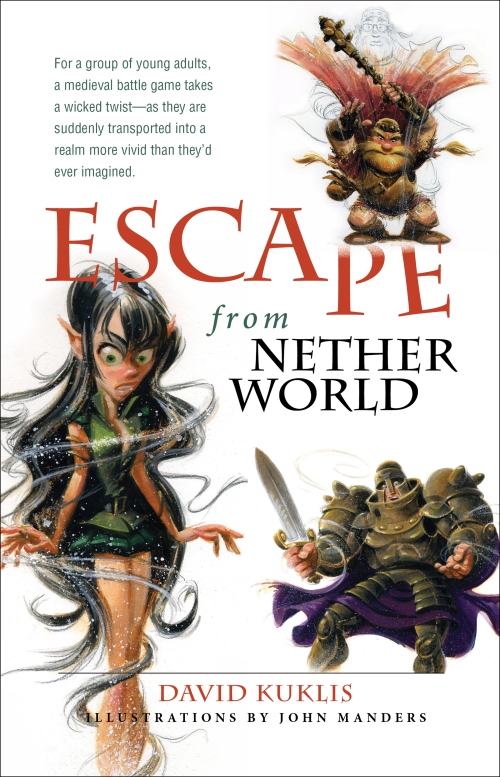
Escape From Netherworld jacket
Hey, gang! Sorry for the interruption in posts—I spent most of last week in New York City visiting art directors, editors and creative directors. Now I’m back and I want to show you something I worked on this summer.
Here is jacket art for Escape from Netherworld—it’s about a group of role-playing gamers who are somehow transformed into their characters and transported into an alternate realm: Netherworld.
My pal, the extraordinarily talented Gina Datres, is the book’s designer and she called me in to illustrate the jacket. After some discussion and rough sketches back & forth we hit on the idea of 3 individual images of the gamers going through their transformation. For the 2 guys, I drew the gamers in pencil but fully rendered their characters in paint. I work with watercolor (gouache), so I traced some of the drawing with a wax candle. Since watercolor won’t stick to wax, you can see the drawing of the gamer ‘through’ the painting of the character. Piper, the elf-girl, doesn’t change in size enough to make that idea work so I made her hair a magical element that swirls around her as it grows.
If you’d like to buy a copy of Escape from Netherworld just click here.
Author: David Kuklis
Designer: Gina Datres
Illustrator: John Manders
Editor: Nan Newell
Published and Printed by:
Word Association Publishers, Tarentum, PA 15084
ISBN: 978 1 59571 994 2
Available for purchase:
wordassociation.com — 1 800 827 7903
barnesandnoble.com
amazon.com
Let’s start with Twiggy the dwarf. As usual, here are the rough sketches, tight sketches, color studies and final paintings.
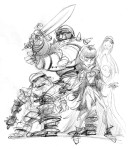
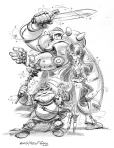

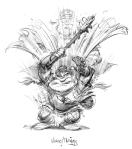
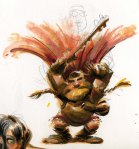



By: johnmanders,
on 8/20/2014
Blog:
John Manders' Blog
(
Login to Add to MyJacketFlap)
JacketFlap tags:
underpainting,
thumbnail,
rum,
alcohol abuse,
hirsute,
pirates,
illustration,
art,
sketch,
character design,
book promotion,
beard,
Ocracoke,
illustration process,
Add a tag
As a follow-up to my last post about Queen Anne’s Revenge, here is the man himself—the terrible Edward ‘Blackbeard’ Teach. I show him in close-up so you can see the slow-match fuses he used to weave into his whiskers and set alight before attacking a ship. You can find him in P is for Pirate, now available in bookstores—or drop me a line in the comments for an autographed copy.
Pirate captains were elected by their crews and could be voted out. To keep his crew in line, Blackbeard constantly showed himself to be more fierce, more outrageous than anyone else on board. Seated with his rogues during dinner, Blackbeard fired a pistol underneath the table and wounded one of the crew, just to remind them who he was.
Blackbeard had to be mindful of his crew’s appetite for liquor—for rum, an ardent spirit distilled from molasses. Without rum, a crew would mutiny, as this excerpt from Blackbeard’s log attests:
‘Such a Day, Rum all out: – Our Company somewhat sober: – A Damned Confusion amongst us! – Rogues a plotting; – great Talk of Separation. – So I looked sharp for a Prize; – such a Day took one, with a great deal of Liquor on Board, so kept the Company hot, damned hot, then all Things went well again.’
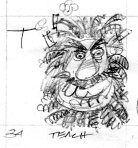
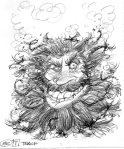



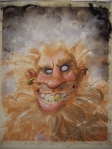
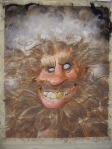
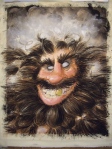
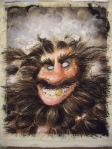
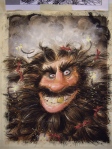
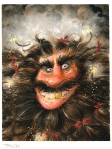


By: johnmanders,
on 8/15/2014
Blog:
John Manders' Blog
(
Login to Add to MyJacketFlap)
JacketFlap tags:
pirates,
illustration,
art,
sketch,
book promotion,
illustration process,
shipwreck,
revenge,
pirate,
Blackbeard,
underpainting,
thumbnail,
baroque,
Bunthorne,
Queen Anne,
Add a tag
Queen Anne’s Revenge, that is. Queen Anne’s Revenge is the name of Blackbeard Teach’s flagship—though I have to admit I don’t know why he chose that name. Queen Anne ruled Great Britain & Ireland while Blackbeard was alive, so maybe he considered himself to be a privateer on behalf of the Crown? Was he not happy with the War of the Spanish Succession? I’d like it if, in the comments, someone could offer a better reason behind Teach’s name for his ship. Writers Alexander Pope, Jonathan Swift & pirate aficionado Daniel Defoe flourished under Queen Anne, so maybe her reign really was culture’s balmiest day—but why did she need to be avenged?
Anyway, he only captained Queen Anne’s Revenge for 3 years before she sunk off North Carolina. And so I had the wonderful opportunity to paint a sunken pirate ship for Eve Bunting’s new book, P is for Pirate. It was also a chance to pay tribute to fantastic illustrator Lloyd K. Townsend. When I say ‘pay tribute to’, of course I mean ‘steal shamelessly from’. I’ve admired Townsend since I was a wee lad, seeing his paintings in National Geographic. One in particular, from 1979, shows the sunken Spanish treasure ship Tolosa. This was my—cough—inspiration for R is for Revenge. Hey, at least I turned the ship around to face the other way!
Herewith, work in progress:


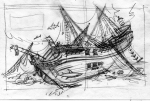


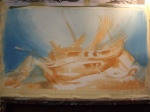
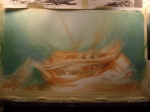

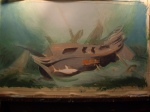
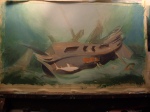
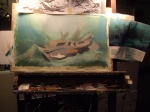
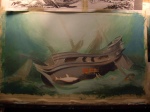
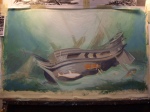

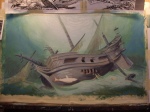
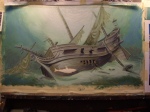
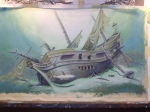
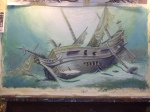
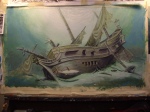
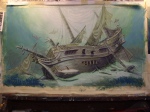



By: johnmanders,
on 8/13/2014
Blog:
John Manders' Blog
(
Login to Add to MyJacketFlap)
JacketFlap tags:
pirates,
illustration,
art,
sketches,
character design,
book promotion,
Elizabeth,
irish,
ireland,
illustration process,
queen,
pirate,
costume,
underpainting,
mayflower,
thumbnail,
Add a tag






















































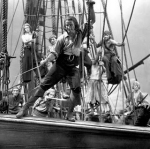
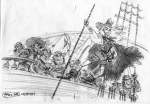
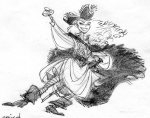
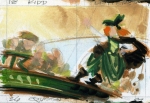
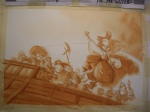
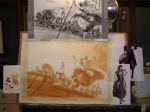
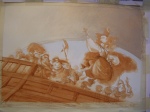

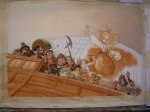
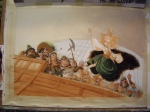
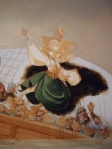
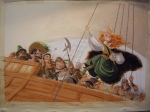
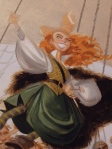
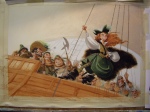
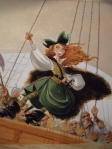
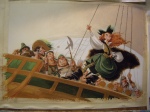
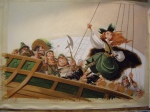
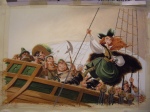
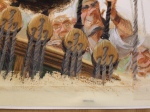
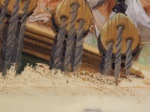
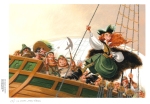
I can’t wait until January, so that I can have the time to be able to pick up this book and really get into it! Looks like it’s going to be lots of fun! Your work looks gorgeous (as usual!) John. The technique is so cool!
Thank you, darling!